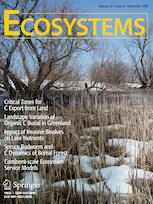Ver ítem
- xmlui.general.dspace_homeCentros e Institutos de InvestigaciónCIRN. Centro de Investigaciones de Recursos NaturalesInstituto de SuelosArtículos científicosxmlui.ArtifactBrowser.ItemViewer.trail
- Inicio
- Centros e Institutos de Investigación
- CIRN. Centro de Investigaciones de Recursos Naturales
- Instituto de Suelos
- Artículos científicos
- Ver ítem
Biotic and Abiotic Drivers of Topsoil Organic Carbon Concentration in Drylands Have Similar Effects at Regional and Global Scales
Resumen
Drylands contain 25% of the world’s soil organic carbon (SOC), which is controlled by many factors, both abiotic and biotic. Thus, understanding how these factors control SOC concentration can help to design more sustainable land-use practices in drylands
aiming to foster and preserve SOC storage, something particularly important to fight ongoing global warming. We use two independent, largescale databases with contrasting geographic coverage (236 sites
[ver mas...]
Drylands contain 25% of the world’s soil organic carbon (SOC), which is controlled by many factors, both abiotic and biotic. Thus, understanding how these factors control SOC concentration can help to design more sustainable land-use practices in drylands
aiming to foster and preserve SOC storage, something particularly important to fight ongoing global warming. We use two independent, largescale databases with contrasting geographic coverage (236 sites in global drylands and 185 sites in Patagonia, Argentina) to evaluate the relative importance of abiotic (precipitation, temperature and soil texture) and biotic (primary productivity)
factors as drivers of SOC concentration in drylands at global and regional scales. We found that biotic and abiotic factors had similar effects on SOC concentration across regional and global scales: Maximum temperature and sand content had negative effects, while precipitation and plant productivity exerted positive effects. Our findings provide empirical evidence that increases in temperature
and reductions in rainfall, as forecasted by climatic models in many drylands worldwide, promote declines in SOC both directly and indirectly via the reduction in plant productivity. This has important implications for the conservation of drylands under climate change; land management should seek to enhance plant productivity as a tool to offset the negative impact of climate change on SOC storage and on associated ecosystem services.
[Cerrar]

Autor
Gaitan, Juan Jose;
Maestre, Fernando Tomás;
Bran, Donaldo Eduardo;
Buono, Gustavo Gabriel;
Dougill, Andrew J.;
Garcia Martinez, Guillermo Carlos;
Ferrante, Daniela;
Guuroh, Reginald Tang;
Linstadter, Anja;
Massara Paletto, Virginia;
Thomas, Andrew David;
Oliva, Gabriel Esteban;
Fuente
Ecosystems 22 (7) : 1445-1456 (Noviembre 2019)
Fecha
2019-11
Editorial
Springer
ISSN
1432-9840
1435-0629
1435-0629
Formato
pdf
Tipo de documento
artículo
Palabras Claves
Derechos de acceso
Restringido
 Excepto donde se diga explicitamente, este item se publica bajo la siguiente descripción: Creative Commons Attribution-NonCommercial-ShareAlike 2.5 Unported (CC BY-NC-SA 2.5)
Excepto donde se diga explicitamente, este item se publica bajo la siguiente descripción: Creative Commons Attribution-NonCommercial-ShareAlike 2.5 Unported (CC BY-NC-SA 2.5)

